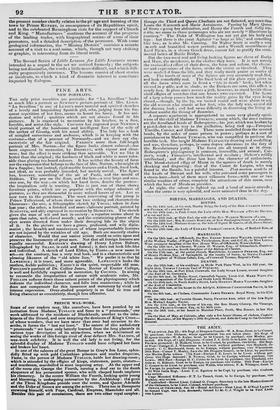FRENCH WAX-WORK.
Sows of our readers may, like ourselves, have been puzzled by an invitation from Madame. TLISSAUD and Sons to a " promenade," one week addressed to the residents of Blackheath, another to the inha- bitants of the Strand, and now tempting the denizens of King's Cross— of whose wonders, that we have more than once had occasion to de- scribe, it forms the " last not least." The nature of this ambulatory " promenade " we have only latterly learned from the long placards in various type descriptive of its attractions, when we determined on seeing the works of this foreign rival of dear defunct Mrs. SALMON, of wax-work celebrity. It is well the old lady is not living, for the splendid display of Madame TUSSAUD would have eclipsed her fame and broken her heart.
In one of the saloons of the great Bazaar in Gray's Inn Lane, splen- didly fitted up with gold Corinthian pilasters and scarlet draperies, Fame, in the person of Madame TUSSAUD, holds her drawing-room ; which is attended by the effigies of kings, statesmen, poets, orators— and murderers, marshalled in most imposing array. At the upper end of the room sits George the Fourth, turning a deaf ear to the dumb eloquence of his persecuted spouse, who with clasped bands implores his clemency. In the centre William the Fourth, looking quite young and blooming, is undergoing coronation by the Archbishop : the genii of the Three Kingdoms preside over the scene, and Queen Adelaide and the Duke of Sussex are among the actors. There too is Bonaparte crowniag himself, with Pope, Cardinal, Empress, Mameluke and all. Besides this pair of coronations, there are two other royal couples;
George the Third and Queen Charlotte are not flattered, any more than Louis the Sixteenth and Marie Antoinette. Passing by Mary Queen
of Scots s:gning her abdication, and Henry the Fourth and Sully tote. ti-ante, we come to those personages who are not merely " illustrious by
courtesy." The Duke of Wellington has not yet got his body and legs : but there is the great Agitator "as large as life," and something like too ; as is also Mr. Canning. Sir Walter Scott is really a very • mloth and beautified waxen portrait; and a Westall resemblance. of Lord By: on, in a showy Greek dress, cannot fail to gratify the senti- mental ladies of Battle Bridge. But the two most real and living-looking figures are those of Burke and Hare, the murderers, in the clothes they wore. It is not merely the vraisembhat effect of their dress, the form and colour, time charac- ter and expressions of the faces, strike the visitor as identical. They were modellsd from the life, and they really merit praise as works of art. The hands of most of the figures are very accurately moddled, and look remarkably real. The fixed look of the glass eyes gives to all the faces when seen in front a " life•in death" look ; but when viewed in p.ofile, and in shade, as the Burkers are seen, this effect is nearly lost. It gives one's nerves a jerk, however, to stand beside these vivid effigies of wretches that one knows were executed. 'f he figure of a lady asleep proves how much the reality gains by the eyes being closed,—though, by the by, we turned round and were about to ask the old woman who stands at her feet, who the lady was, so real did time duenna look ; and had some difficulty in discerning the living at- tendant amidst the throng of dummies.
A separate apartment is appropriated to some very ghastly speci- mens of the skill of Madame 'fuss-silo; among which, the most curious are the decollated heads of Robespierre—his jaw, which was broken by a pistol-shot on his way to the guillotine, being tied up—Fouquier Tinville, Carrier, and Hebert. These were modelled from the severed heads, by the order of some person in power ; perhaps as a sort of punishment to Madame Tessaun, who was compelled to perform the horrible task. She taught Madame ELIZABETH drawing and modelling, and was, therefore, perhaps, in some degree obnoxious to the fury of the Revolutionary party. The faces are all tranquil as in sleep. Robespierre's physiognomy is common, insensible, and animal ; Car- rier's, weak ; Fouquier's, intellectual and resolute ; Hebert's mildly intellectual ; and the three last have the character of enthusiasts. The blood-stained effigy of Marat in the agonies of death is merely shocking and disgusting : that of the Count de Lorgne, who was found in the Bastile, has a painful interest. Post-mortem models of the heads of Stewart and his wife, who poisoned some passengers in a steam-boat—both of them most villanous faces—with one or two similar trophies of crime, complete the attractions of this room, over
which the bust of Mirabeau presides. At night, the saloon is lighted up, and a band of music attends ; when the scene is very splendid, and more animated than in the day.


























 Previous page
Previous page